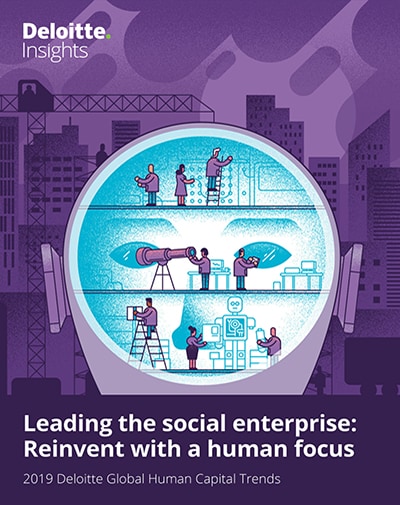
Accessing talent: It’s more than acquisition 2019 Global Human Capital Trends
6 minute read
11 April 2019
In today’s world of changing jobs and skills, organizations have an opportunity to take a fresh look at how they approach talent acquisition, exploring new approaches to determining what talent they need—and where and how to find it.
During the last decade of economic expansion, organizations have focused on finding the right talent to drive business growth. But with record-low unemployment rates and skills shortages in many technical areas, recruiting has gotten harder, leading to an escalating war of employment brands, recruitment marketing campaigns, and artificial intelligence (AI)-driven tools to deliver recruiting excellence. In 2019 and 2020, as the economy is likely to slow,1 we think a new approach is needed. Rather than automatically opening a job requisition when a manager needs a role filled, it’s time to think about how organizations can continuously “access talent” in varying ways: mobilizing internal resources, finding people in the alternative workforce, and strategically leveraging technology to augment sourcing and boost recruiting productivity.
As the economy continues to grow and unemployment remains low in developed countries, recruitment has become harder than ever. This year, 70 percent of respondents to the Global Human Capital Trends survey cited recruitment as an important issue, and 16 percent told us it was one of the three most urgent issues their organization would face in 2019. Economic data points out the issue: In the summer of 2018, the quit rate in the United States, the percent of employees who leave their jobs each month, rose to 2.4 percent, the highest it has been since 2001.2 On an annual basis, this means that more than 25 percent of the US labor force changes jobs each year. Elsewhere, leading economies including Japan, the United Kingdom, Germany, and others saw their unemployment rates fall to lows not seen in decades;3 China’s unemployment rate hit 3.8 percent in the fourth quarter of 2018.4
Beyond high rates of employee-initiated turnover and lower rates of unemployment, other challenges unique to today also exist. The accelerating adoption of automation is creating intense demand for technical skills that don’t widely exist in today’s workforce. And many employers believe that large numbers of college graduates are missing skills in complex thinking, collaboration, teamwork, and communication.5 All of these challenges make finding qualified talent particularly difficult (figure 1).

The right capabilities may be right under your nose
Learn more
View 2019 Global Human Capital Trends
Download the Deloitte Insights and Dow Jones app
Download the full report or create a custom PDF
Deloitte’s 10th annual Global Human Capital Trends Report is coming soon. Get it first by signing up!
In this talent-constrained environment, we see three main sources of capabilities that can be leveraged more strategically. While each of these tactics may seem obvious on the surface, none of them have been tapped to their fullest potential to date, making them some of the most promising ways for organizations to go after needed talent.
First and foremost, organizations should look much more strategically at moving current employees into available opportunities across the enterprise. This is a key differentiator for both recruiting and talent; in fact, it is so important that we have written a separate chapter about it in this year’s report. An internal hire need not be a “perfect” fit for a role to be afforded an opportunity for growth or skills development. Studies show that reskilling an internal hire (such as teaching a math major to code) may take a year or so, but it can be done for as little as one-sixth the cost of hiring an external candidate.6
While internal talent mobility may not be a new idea, it’s certainly an area where organizations have much room for improvement: Forty-five percent of this year’s survey respondents said that their employees lack information on available roles inside their organization. With that statistic as the starting point, it’s perhaps not surprising that 56 percent of our respondents told us that it was easier for people to find a new job at an outside organization than with their current employer.
The second source of talent is the “alternative workforce”—people who work in gig arrangements, as contractors, as contingent workers, or in other nontraditional arrangements. This tactic appears to be especially relevant for companies looking for ways to flex their workforces in response to changing business conditions. It can also be an important factor for employers in countries where strict labor laws, high severance requirements, company-specific agreements with workers’ councils, and other factors create an environment where hiring full-time employees is often less appealing due to difficulties with layoffs as business conditions change.
As we discuss in our chapter on the alternative workforce, the number of people in alternative work arrangements is on the rise around the world. The availability of these types of workers is an opportunity for organizations that want to immediately bring capabilities into the organization that can deliver on specific outcomes.
Rewiring how organizations use technology to recruit
The third, and the potentially most transformational, way to find more qualified talent is to leverage new technology. Why the most transformational? Because it is the area where recruitment organizations are the furthest behind. Consider these statistics:
- In this year’s Global Human Capital Trends survey, when we asked respondents to rate their recruitment functions, we found that only 6 percent believed they had best-in-class processes and technology.
- Eighty-one percent of our survey respondents believed their organizations’ recruitment processes were standard or below standard.
- In a separate Bersin™ study, only 12 percent of respondents reported having strong sourcing technology, and only 9 percent said they had strong screening technology.7
In addition, a large proportion of this year’s Global Human Capital Trends survey respondents see the role of technology increasing across a range of recruiting processes over the next three years (figure 2). These findings lend support to the latest Bersin™ research on talent acquisition, which shows that optimizing technology—using data to find, source, and select candidates more efficiently and taking a data-driven, expedited approach to hiring—is one of the recruiting function’s biggest opportunities.8

The good news here is that technologies are available today that can revolutionize recruiting. A decade ago, organizations invested in applicant tracking systems as the core platform to help collect, catalog, manage, and track candidates. More recently, an explosion of new tools, many powered by AI, have come on the market to make that process more scientific, scalable, and effective. Mature organizations now use AI-driven chatbots to enable a more streamlined approach to the application process; video interviews can screen and assess candidates for their fit to a particular role and the organization; and many new tools can help with targeted job advertising and expansive candidate searches. Tools are available, for instance, that combine publicly available data with machine learning capabilities to create a complete picture of the candidate, then highlight factors that differentiate each candidate based on their fit for the role.
Consider a simple example. A new AI-based assessment system from Pymetrics can assess a wide variety of human traits and skills, and map them directly against the characteristics of the highest-performing people in various roles.9 By using the tool, organizations such as Unilever and others have dramatically expanded their aperture for recruitment, hiring people who may not have expensive college pedigrees but are competent, ambitious, and ultimately able to succeed.10
As another example, Mya, one of the leading providers of AI-based chatbots for recruiting, has been able to reduce the time it takes to screen candidates by 30–50 percent or more, often giving recruiters days or a week of extra time to spend on outbound recruiting, interviewing, and other high-value activities.11 And IBM’s new Candidate Assistant automatically matches candidates to the right jobs, increasing quality of hire by orders of magnitude.12
Accessing talent in the social enterprise
Beyond the obvious link that effective sourcing provides to productivity and business performance, there is a social aspect that cannot be forgotten. Just as new approaches are enabling organizations to find talent more efficiently and effectively, they are also enabling organizations to expand their view of talent. As mentioned above, Pymetrics has enabled Unilever to greatly expand its candidate pool by identifying candidates without college degrees that have become highly effective marketing managers.13 Job networks like The Mom Project help companies find highly skilled people who want to come back to work. And talent networks such as UpWork, Fiverr, 99Designs, Catalant, and others provide validated access to highly skilled candidates that might not otherwise be on the corporate talent radar. In the social enterprise, organizations that broaden the lens through which they view capabilities can not only provide opportunities to individuals whom a more conventional approach may have missed but also change their talent brand in the process.
The war for talent is raging more fiercely than ever. To win requires more than execution; it demands reinvention—not just of the talent acquisition process, but of the talent acquisition mindset. To do this, organizations should rethink how to access existing internal talent, reset traditional expectations on where talent can be found and what it looks like, and rewire the recruiting process by taking advantage of advanced technologies like AI. The talent is out there if you know how to look.

© 2021. See Terms of Use for more information.
Explore the collection
-
From employee experience to human experience Article6 years ago
-
Talent mobility Article6 years ago
-
Rewards Article6 years ago
-
HR cloud Article6 years ago
-
Looking ahead Article6 years ago
-
2019 Global Human Capital Trends Collection





















